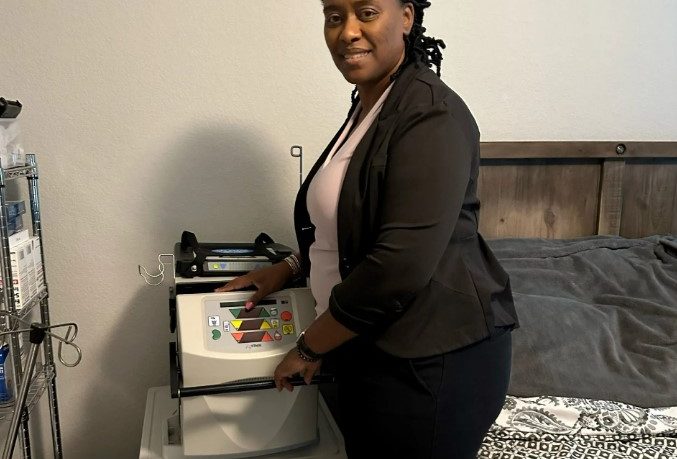By Alexa Spencer,
Word In Black
When Pflugerville, Texas, resident Melissa Bensouda gave birth to her third child in 2002 at age 27, she dreamed of dressing her baby in cute outfits and documenting all the usual first-year milestones. Instead, she soon found herself worrying about staying alive.
“I definitely did not expect to see my children graduate from high school,” she says.
Six months after giving birth, a lab test revealed that Bensouda’s kidneys were functioning at half-strength. She was diagnosed with Stage 5 kidney disease.
Twenty-one years later, Bensouda, now 48, has one kid in high school but has seen her other two children graduate.
“I wanted to see them in their life journey, and they’re reaching milestones,” Bensouda says. “Some that I never met.”
The tech that sustained her physically and emotionally? Home dialysis.
Black Americans are most at risk
An estimated 37 million Americans live with kidney disease, according to the National Institute of Diabetes and Digestive and Kidney Diseases. But Black Americans are four times more likely than White Americans to develop the disease due to high rates of diabetes and high blood pressure, the most common causes of kidney failure.
Chronic kidney disease occurs when the kidneys — two fist-sized organs located below the rib cage — fail to clean the blood and filter out extra water. This can cause waste and fluid to build up in the blood, and may lead to heart disease or stroke.
There is no known cure for chronic kidney disease, though the symptoms are often managed with medication.
If the condition progresses to end-stage kidney disease (also called end-stage renal disease or kidney failure), a kidney transplant or dialysis — when an artificial kidney machine cleans the blood — is required to stay alive.
The average life expectancy with dialysis is five to 10 years — although some people live 30 years longer.
The dialysis clinic experience
Bensouda began dialysis at clinics after her diagnosis. She went in multiple times a week — like most patients. After a while, she noticed a decline in her mental health. Research shows depression is common among people being treated for kidney disease due to isolation, fatigue, and an overall major life change.
“It was depressing and scary because I was pretty much the youngest person that was going into the clinic to do treatment,” Bensouda recalls.
She says she regularly saw older patients “hurting,” “lashing out,” and “incoherent” as they suffered from low blood pressure during treatment, a common side effect of dialysis due to a drop in fluid levels.
“It was very difficult for me to reconcile that when I would go into the clinic, so I would basically just go to sleep until my treatment was over,” Bensouda says.
She found relief when a nurse recommended she join a home dialysis program. After accepting, she completed six weeks of training, where she learned to insert needles, set up and clean the machine, and diagnose any warnings or alarms.
The switch helped her mentally because she could do it from the comfort of her house, on her own time, while also being present for her children.
The realities of at-home dialysis
Home dialysis offers a range of advantages: More time for family, work, and travel. Patients can also dialyze on their own schedule instead of traveling to a clinic three times a week for four-hour sessions.
Jenny Shen, an associate professor of medicine at the University of California in Los Angeles, says her patients who dialyze at home appreciate its flexibility.
“They seem to be a lot more independent, a lot more free, and a lot less burdened by it,” she says.
Despite the perks, home dialysis is less popular than clinic- or hospital-based care, but that’s changing. Between 2010 and 2020, home dialysis use among newly-diagnosed patients with kidney failure grew from 9.1 percent to 13.7 percent, according to the National Institutes of Health.

Black patients, however, remain less likely to use home dialysis at 7.3 percent, compared to 9.3 percent of White patients.
Previous research by Shen and Katherine Rizzolo, a nephrologist at Boston University, found that certain socioeconomic conditions, such as unstable housing, cause less access among Black people.
Despite the perks, home dialysis is less popular than clinic- or hospital-based care, but that’s changing. Between 2010 and 2020, home dialysis use among newly-diagnosed patients with kidney failure grew from 9.1 percent to 13.7 percent, according to the National Institutes of Health.
Black patients, however, remain less likely to use home dialysis at 7.3 percent, compared to 9.3 percent of White patients.
Previous research by Shen and Katherine Rizzolo, a nephrologist at Boston University, found that certain socioeconomic conditions, such as unstable housing, cause less access among Black people.
“[Home dialysis requires] a lot of boxes. You have to get a certain amount of backup materials. You have to have a space for the machine,” Rozzolo says. “So, if you don’t have a space for that because you have unstable housing, a lot of places won’t feel safe putting you on this machine because you’re prone to get infections.”
Shen adds that more research needs to be done around potential bias among practitioners, considering that dialysis facilities that serve high rates of Black patients have lower rates of home dialysis referral and initiation.
“Another issue is just fewer home dialysis programs are available in communities where Black patients tend to dialyze,” she says.
While insurance covers much of the expenses for home dialysis, there can be hidden costs. Unpaid time off from work for training can make it unaffordable, as well as money for a caregiver when additional help is required.
“In addition, the amount of time it takes for a patient to set up the machine, to be on the machine, all of that is time that they can’t work,” Rozzolo says.
Dialysis, in general, is costly. Depending on a patient’s insurance status and type of dialysis, expenses can range from $10,000 to $90,000 annually.
Bensouda says it’s a lifelong debt that she’ll never be able to pay fully.
“There’s never a year that I don’t have expenses related to either dialysis or hospitalization or medication or taking time off because I’m not feeling that great…that’s just my reality,” she says.
At home, Bensouda dialyzes three times a week for eight hours each, with the option to perform an additional treatment, if needed. The process requires inserting large needles into her body, a task she believes keeps some patients from giving home dialysis a try.
“There is responsibility here. It’s not like it’s just the easiest thing in the world. It takes time. It takes commitment,” she says.
Hope and a kidney transplant
Bensouda remained on home-based dialysis for a decade while on a kidney transplant list. She was matched with a donor but encountered complications five years after the surgery.
“I got really sick one holiday season and went into the emergency room and found out that my kidney had been fully rejected,” she says.
With no choice but to return to dialysis, she once again chose the type that brought her the most comfort.
“I knew that if I was going to survive emotionally this experience and continue with my life goals for my family, I would have to go back to home dialysis,” Bensouda says.
A 100-pound portable hemodialysis machine allowed her to reclaim her love for traveling. She’s comfortably visited Kansas City, Missouri, and Cabo, Mexico.
“I needed that machine in order to continue living my life the way that I need to,” Bensouda says.
Part of living her life is pursuing a master’s degree in public health and advocating for home dialysis accessibility in her community.
“We need to push to make these types of therapies available to more people,” she says. “It really was a lifesaver and a game changer for me.”
This article was originally published by Word In Black.



